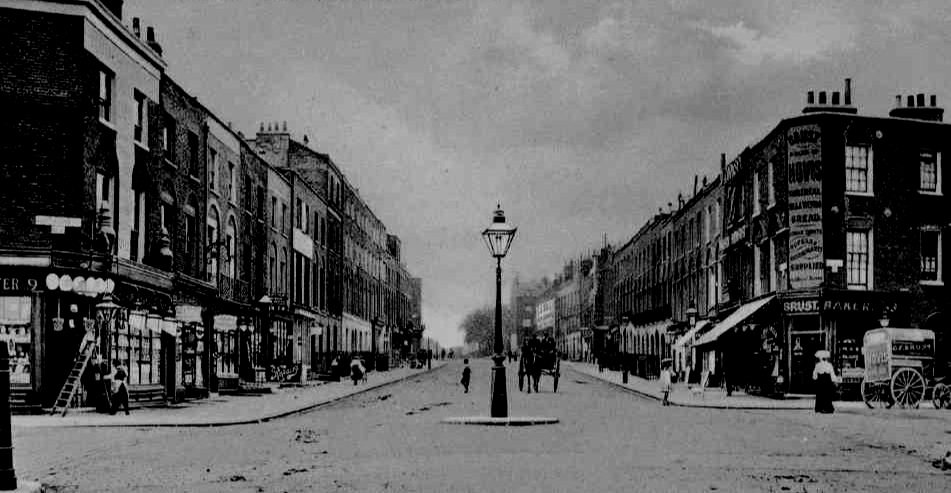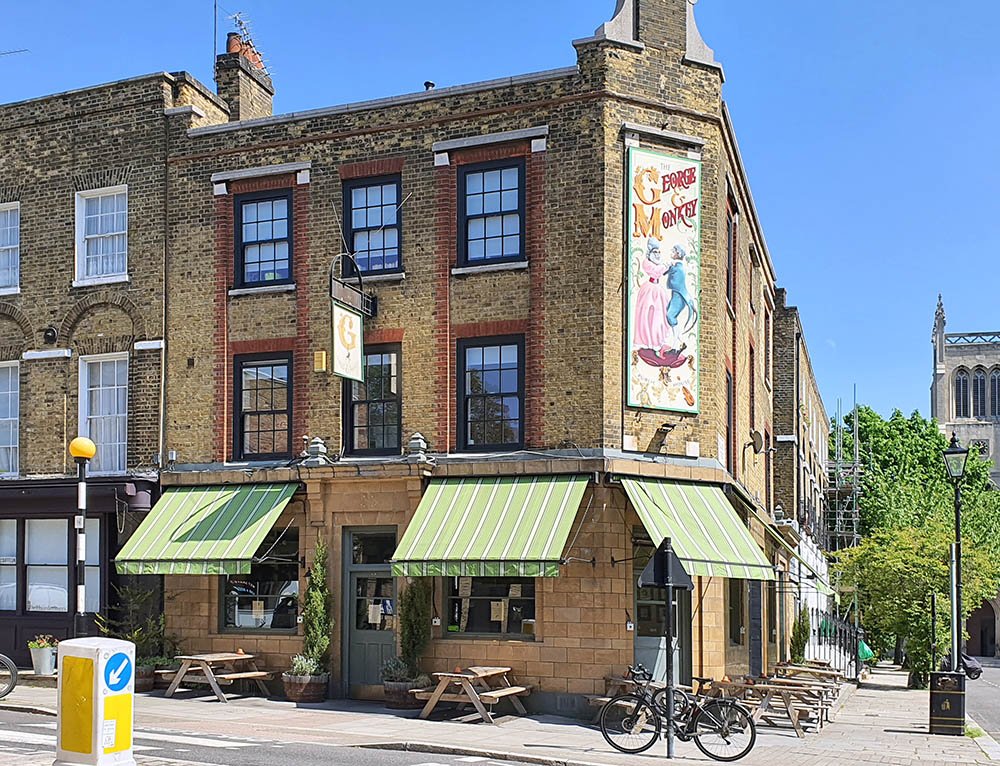
History
Our unique area situated on the side of a hill overlooking the city of London is well researched and documented in a wide array of publications and historical records, which 21st century technology has made easily accessible for those with a passion for historic detail.
The purpose of these pages is an attempt to re-connect us to the everyday human aspects of our history and provide links to resources for the curious to peruse at their leisure.
We are interested in receiving contributions from our members and friends and would invite anyone with stories and anecdotes to contact us at info@amwell.org.uk
1609 – Sir Hugh Myddelton and his New River
London’s population exploded in Tudor times: from about 120,000 in 1550 to 250,000 in1600. In a seriously over-crowded city with no system for dealing with sewage, hygiene was a major problem.
Londoners only had access to water from wells or from the (filthy) Thames, via a large waterwheel at London Bridge. Although Acts of Parliament had been passed in 1605 and 1606 to improve the situation, it was a challenge issued by King James that finally brought about a radical solution to London’s water shortage.
Hugh Myddelton, a goldsmith, banker and friend of Sir Walter Raleigh, undertook to build a new water supply. Work started in 1609 on a canal that was around 40 miles long, 3 metres (10 feet) wide and 1 metre (3 feet) deep and took four and a half years to build. The source of this canal, which became known as the New River, was a series of springs in Great Amwell in Hertfordshire. From here it flowed over a rambling route that had to follow the contours of the terrain to a reservoir known as the round pond at New River Head .
Water was then taken from the reservoir into the city in pipes made from hollowed elm logs and then into individual houses through lead pipes. By 1670, up to two-thirds of houses in many parts of London had running water from the New River.
Solving the problem of bringing fresh water to the city didn’t just involve technical challenges: Myddelton also had to deal with objections from owners of land that he needed to cross. He soon ran out of money to pay them off, however he managed to persuade the King to step in and finance half of the costs of the project in return for half of the profit.
The New River was opened with a ceremony hosted by Myddelton’s brother, who was Lord Mayor of London at the time. In 1622, Myddelton was rewarded for his efforts by the King, who made him a Baronet.
As an open water course, the New River couldn’t entirely solve London’s hygiene problem, but it did improve things. Now, having been shortened and straightened, it still provides water for some Londoners. It is mostly covered over and stops at Stoke Newington ponds but you can still see some uncovered parts, visit the site of New River Head at the end of Myddelton Passage or thank Sir Hugh Myddelton at his statue on Islington Green.
1752 – A view of the City of London from a painting by Thomas Bowels
Source – A Village in London published by The Amwell Society 1974 revised 2004/5
1825 – Housing Boom (and Bust); Amwell Street is Built
In the early 1820s the major landowners of the area, The New River Company and The Lloyd Baker Estate, reached an agreement for the building of a main thoroughfare along the line of a popular path beside the New River land. Originally to be called Union Street, it ran from Pentonville Road down the hill to the Parochial School. In 1826 it was decided to re-name the street after one of the sources of the New River: it became Amwell St, and below the school the development was a northern extension of the existing Rosoman St. Although the plans were agreed by the landowners, the actual construction was leased to a number of speculative builders who did not necessarily have the skills or the means to complete their project.
In 1820 William Wade, a carpenter and builder, contracted to build 18 houses on the west side of the street known as Thompsons Terrace (the name still appears on a plaque in 47-49 Amwell Street); he managed six houses before going bankrupt in 1824.
In 1822 Edward Ffyfe took an agreement to build 30 third rate houses on the east side of the street, he assigned the work to a whole series of subcontractors but he too went bust long before the work was finished.
Fascinating details of all the buildings in our area can be viewed online. English Heritage’s exhaustive Survey of London is available online at www.british-history.ac.uk. The Amwell triangle can be found in Volume 47 Northern Clerkenwell and Pentonville.
1830 – Clerkenwell Parochial School
Originally founded in 1700 the school moved to the developing Amwell area in 1830; it is still housed in the original building although the children are all educated together and are not required to use the separate BOYS and GIRLS entrances, which can still be seen. The site had been used as a pipe yard by the New River Company and was no longer needed when pipe replacement work had been completed. The new school had 548 pupils (338 boys and 210 girls). In the 1890s this number rose to 900 pupils and the school was full! The number of children attending the school has steadily declined to today’s numbers, but given the school’s long history many of them are attending the same school as their parents and grandparents.
1881 Census – Population Movement
Census records for the area in 1881 show that people were immigrating from many parts of Country and from Italy.
The Public House at 1 Eliza street, Sadlers Wells was occupied by Inn Keepers Peter and John Poncie, their barmen John Floy and Matley Cezza, and their lodger Tancrede Gobbe, a looking glass maker; all of them had been born in Italy.
At No. 7 Yardley Street (another Public House) lived Arthur and Charlotte Sharp and their children. Arthur was born in Clapham and Charlotte in Marylebone in 1881, they were both 43 and gave their occupation as Inn Keepers. Their married life had seen them moving all around the capital with their growing family: Earnest 19 born in Chelsea; Amy 17 in Poplar; Blanche 13 and Percy 11 both born in New Cross and the youngest Miriam, 9, born in Stepney.
1881 Census – Public Houses
1881 sees the Amwell area with a rapidly expanding population. Many people are moving in from elsewhere. Serving them were at least 15 Public Houses, with many more in the surrounding street.
Still with us are:
The Harlequin in Arlington Way was founded in 1840s.
The Old China Hand, Tysoe St. (formerly The Three Crowns) appears in the 1871 census.
Renamed George And Monkey. It was formerly a pub known as the Fountain, from the original development of Amwell Street in 1825.
Other examples are The Union Tavern in Kings Cross Road, The Easton (formerly The Queens Head) off Wilmington Square and The Shakespeare’s Head in Arlington Way. However we have lost The Percy Arms (which is now a private house), The King William IV, The Merlin’s Cave and The New Merlin’s Cave, The Sir Hugh Myddelton and no doubt many other unlicensed establishments.
1905 – Lloyd Family Dairy Opens
1905 The Lloyd Family open a dairy on the corner of Amwell Street and River Street. The business continues in the family for three generations.
1933 – Merlin Street Baths
Source – 1986 Amwell St. calendar by Austin Head.
The building of the first public baths stems back to the Victorian era and a 1844 movement called the Association for Promoting Cleanliness Among the Poor, which aimed to provide washing facilities for those members of “the poorer working classes” who did not have access to them in their homes.
1846 saw the passing of the Public Baths and Wash Houses Act and then, in 1852, Baths and Washhouses for the Labouring Classes, which aimed: “To promote the health and cleanliness of the working classes, and as a necessary consequence, improve their social condition and raise their moral tone, thereby, tendering them more accessible to and better fitted to receive religious and secular training.”
Despite many reviews and discussions on the need for wash house facilities in Finsbury Borough it was not until the need was truly deperate that action was taken. The chairman of the Council’s Baths and Washhouses Committee quoted the following facts in justifying the need of the Borough: “out of 20,005 families living in the Finsbury Borough in 1929, 4,917 shared a single room and 7,253 lived in two rooms. Most had no bath or wash house, 4,248 families lived in block dwellings with need of a better bath and washing facilities. Of the Borough’s 12,000 dwellings no more than 500, or 4%, had private baths.”
Merlin Street Baths were one of the eventual Council commissions and opened in 1933. The Architects were father and son team, A. W. S. Cross and K. M. B. Cross, who were the leading municipal baths specialists in the country.
The Merlin Street Baths were later destroyed by fire; however their Ironmongers Row baths near Old Street survive to this day.
1930s/40s – Berthold Lubetkin, Our Very Own Modernist
Berthold Lubetkin was the architect of Bevin Court, which was built just after World War II on the site of Holford Square, off Great Percy Street, which received a direct hit from a land mine during the blitz. His finest building was the Grade I listed Finsbury Health Centre in nearby Pine Street, opened in 1938 as part of the unrealised Finsbury Plan to tackle poverty and disease. Lubetkin famously said that “nothing is too good for ordinary people”.
For a more comprehensive article about Lubetkin and his work click here.
1942 – Lenin Memorial
On 13th March 1942 a bust of Lenin was erected in Holford Gardens, a memorial given to the people of Finsbury by the Russian Embassy in London. For more information click here. See also a BBC article from 2010. Lenin Memorial Unveiled – original British Pathe footage of the ceremony. The bust is now on display in the Islington Museum.
1974 – Communist Manifesto
Electioneering campaign for Islington’s 1974 Communist Candidate Marie Betteridge.
2005 – Banksy
The Girl with the Cash Machine – Rosebery Ave, adjacent to Café Maya. Later obliterated by Islington Council, now partially recovered and protected.











